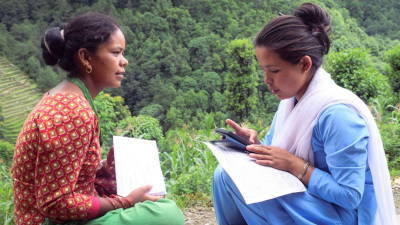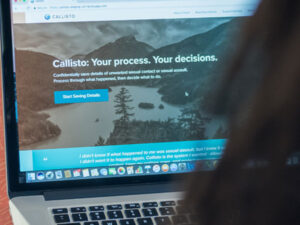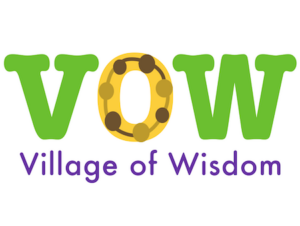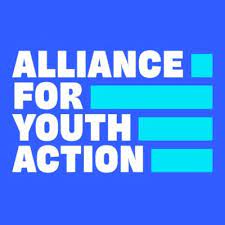Community Health Impact Coalition is a field catalyst, bringing together aligned health organizations and thousands of community health workers (CHWs). The organization works to professionalize CHWs by providing courses and advocacy on guidelines, funding, and policy. They also conduct research to inform global guidelines that ministries of health use when designing their health provisions.
Madeleine Ballard and Godfrey Ouma Haduba of Community Health Impact Coalition spoke with Alec Saelens on December 20, 2023. Click here to read the full conversation with insights highlighted.
Alec Saelens: Could you please introduce yourselves as individuals and describe the problem you are addressing with your organization? How is your organization responding to that problem?
Godfrey Ouma Haduba: I’m Godfrey Ouma Haduba, from Busia County, Kenya. I’m a community health worker, and I work in very hard-to-reach areas. Sometimes [the issues are environmental], like flooding, or drought. Sometimes we are in malaria endemic-prone areas, where malaria is rampant, where there is malnutrition, and where children are suffering from pneumonia, diarrhea, and other diseases. I work under Living Goods, which collaborates with county governments. Living Goods has existed in our area since 2016, and it has trained most of us, as well as over a thousand workers under ICCM [Integrated Community Care Management], an organization that addresses malaria, pneumonia, diarrhea, and malnutrition.
During our first years, there were challenges because we had been trained, and some of our people were not catching up. The community was somewhat aggressive because they were not used to such organizations. We faced challenges doing house-to-house visitation, and the administration thought that we were collecting data without information. But we told them that we were counting, and they gave us a nod.
Living Goods started in Uganda and has moved to Kenya. It started in three counties: Busia, Kisumu, and Kisii. We in Busia were the last batch to be trained, and now it has spread further, to other counties. In Busia, we faced such challenges because we were new, but at the moment, everything is okay. People have caught up. They’re doing well and we are also doing well. The incentives are coming in.
In regards to CHIC [Community Health Impact Coalition], I was one of the first ones to do that training worldwide. That advocacy training sharpened me a lot. I learned that we had working doctors in China, and Bangladesh, and [many other countries], and they have struggled, too. Dr. Martin at CHIC has been a key person, introducing us to various people and various forums. Now, we are seeing people like Margaret Odera and Prossy Muyingo going places, and it’s because of advocacy. Dr. Madeline pushes the agenda, and I like that. Recently, I’ve seen changes in Kenya around community health workers being recognized. We have been recognized by the president himself. I thank Dr. Madeline.
Dr. Madeleine Ballard: I’ll give some more context. Godfrey described his work really well as a community health worker. He performs essential work to treat children, mothers, and other adults. Community health workers have been around for many years. There’s a lot of evidence, many randomized trials and rigorous studies, on how community health workers can reduce the amount of sickness and death in a population. We also know that most national-scale programs don’t move the needle on either of those things. We know that millions of community health workers aren’t salaried and aren’t supported with the training they need. They’re out of stock a third of the time. About 70% of CHWs [community health workers] are women.
You’re getting this triple-sided human rights issue where CHWs are exploited from a labor perspective, then there’s a gender element, and ultimately, if they don’t have what they need to perform, they’re less effective for patients. The bottom line is that a billion people are going to go their whole lives without ever seeing a health worker.
Community Health Impact Coalition is a team of thousands of CHWs like Godfrey, and we are aligned with health organizations like Living Goods. They are one of our co-founders, and they’re making professional CHWs, like Godfrey, the norm worldwide by changing guidelines, funding, and policy. Together we do research to inform global guidelines that ministries of health use when designing their health provisions. We collectively act as a block in advocacy to increase the amount of money for professional CHWs who are invested in community-based care. Then we activate in-country networks of community health workers to demand pro-CHW policy nationally.
The vision and the result is a world full of professional CHWs who are salaried, skilled, supervised, and supplied like any other health worker. Then, there will be quality of care for all. Godfrey was one of the first people who did this online advocacy course called chwadvocates.app. It’s a progressive web app. You can navigate to it yourself, and you don’t need to download anything. You just put in your phone number, and you start learning. The goal, which Godfrey described so well, is to take this workforce, which by definition is working in rural areas where they’re often the only person covering a broad geographic distance, and give them a tool they can use to organize for better conditions and to bring people together.
For a century, community health workers have not been in a position to do that. Unlike garment workers, they aren’t standing next to each other each day in the factory. It’s a labor force that’s geographically distributed. It’s a labor force that’s predominantly women. Some portion of it is illiterate. Whereas there’s an International Council of Midwives and an International Council of Nurses, there’s no International Council of CHWs, and often there are no national associations. When policy gets made, CHWs are not at the table. As we like to say, “If you’re not at the table, you’re on the menu.”
Godfrey was part of the first group of CHWs, and now about 7,000 have signed up for the course to start to change these issues and get acquainted with the fact that, first of all, even if you’re in a remote area by yourself, you’re part of a broader movement. You’re a part of a whole history of CHWs that have come before you. Second of all, you’ve been recognized. You were recognized in 1978, in the Alma-Ata Declaration that set the goal of health for all and said that community care was essential to get us there.
Alec Saelens: Can you share more about the Alma-Ata Declaration?
Dr. Madeleine Ballard: The Alma-Ata Declaration was a landmark moment. It was an international conference on primary healthcare held in 1978, and it was huge. It brought together the WHO, UNICEF, about 130 countries, 3000 representatives, and 70 international organizations. That’s where the phrase, “Health for all,” was first coined, first committed to, and articulated. Up until that point, all we had were disease-specific campaigns. The campaign to eradicate smallpox was successful, but then we tried to eradicate malaria, which was unsuccessful. There was a realization within public health that people have integrated health issues. If you have diabetes, it’s probably co-morbid with TB. It doesn’t make sense to treat one and not the other.
We need to establish healthcare systems in countries across the world that provide a range of essential services to everybody. The Alma-Ata Declaration had the goal of achieving comprehensive and universal healthcare by the year 2000. Obviously, we’re still on that journey, but it’s still something worth harking back to because it was the first strong articulation of that goal, and it remains part of Sustainable Development Goal 3 today, which is, essentially, to achieve what was laid out in that blueprint. That is important to be aware of, and there’s been work done since then. One of the things that Godfrey mentioned was the WHO guideline. There was no guidance from the World Health Organization about community health workers until 2018. Suddenly, and this was something that the coalition helped drive, we have a guideline that says CHWs should be salaried. That was another landmark moment, as this had been a big debate for decades. If we give community health workers money, are we going to undermine their intrinsic motivation?
For a lot of people outside the aid world, that’s a little crazy to hear. Who else does work and doesn’t get paid? But historically, it’s something that we’ve seen. They used to say the same thing about soldiers. “If we pay soldiers, they’re going to become mercenaries.” I don’t necessarily want to compare the two professions, but we understand that everybody who devotes a fair amount of time to something has some intrinsic motivation, and that’s fantastic. But they also probably have kids to send to school and a family to feed. How, then, do we make that a viable option for them? We need to make them aware of the larger context. What we’ve seen is that CHWs have been excluded from the conversation around policies that directly affect them. But once CHWs are in the room, they’re some of the most powerful speakers in that room. They have authority and they know what’s required to get healthcare to everyone because they’re on the front lines every day.
Our course is a basic advocacy and storytelling course. How do you package your story in a way that is connected to an instrumental policy demand and gets us further down the field? When you finish the course, you get connected, as Godfrey said, to other advocates in your area. He mentioned Margaret Odera, who’s been a big advocate in Kenya and is at the forefront along with Sheringham and so many other people in creating the first national association of CHF [Children’s Health Fund] in Kenya. They’re fighting right now to be registered, and they were key in getting that presidential recognition and inciting Kenya’s recent policy change.
What’s essential is not just that this group will win the national policy and take advantage of the global, enabling environment that we created, with better guidelines and better funding opportunities, and make it real in their area. If a subsequent president ever comes down the line and says, “Hey, we want to reverse these gains,” CHWs now have a voice in the country and will fight back. I think Godfrey was the spark of what’s been a really crazy two years for Kenya in this election process, the spark for change. Community health volunteers now get stipends, they’re digitally equipped, and they’re now called community health promoters.
Alec Saelens: That’s incredible. Congratulations, Godfrey, for that work. If I understand correctly, there are two tiers of beneficiaries. There are beneficiaries in the communities, whom the community health workers are supporting, but the main and immediate stakeholders who benefit from the work of CHIC are the community health workers themselves. They receive training, guidance, and templates for how to organize and build policy for their own governments.
Dr. Madeleine Ballard: Yes. We’re bringing together CHWs and other allies. CHWs are doing research, and we’re bringing them together with university professors, folks with PhDs, epidemiologists, and economists to do the implementation science research that answers the question: How do you best design these programs for success? The answer we found through research is some pretty obvious stuff. Like every other workplace, it’s salaries, supplies, a mutually reinforcing cycle. Godfrey, Margaret and others will try to advocate, they’ll face objections, and they’ll say, “We’re being told this, that, and the other thing about why this is not possible.” They’ll communicate that back to the CHWs and researchers on the research team who will say, “Well, let’s test that assumption. Is that a good way of organizing care? Where have we seen that work, or not work, elsewhere? You say it’s too expensive; have you calculated what it costs?”
We look at these questions in a rigorous way. They’ll publish findings in reputable places like Lancet Global Health, Human Resources for Health, and other academic journals that the World Health Organization and Africa CDC use to develop their guidelines because they need peer-reviewed research. They’ll publish it in a format that guideline makers can easily read and access. Then the advocacy team will turn it into a campaign, make it famous, and get it embedded in funding agencies so the CHW advocates can then say, “You need to talk to the Head of Community Health in Malawi down the road because they’ve already done this and here was their experience.” Or “Here’s a paper about the design, the cost, the implementation.” It’s this loop where we are surfacing these assumptions, testing them, and bringing some of that evidence to bear alongside the powerful and relevant firsthand professional expertise of folks like Godfrey.
Alec Saelens: In terms of understanding the specificity of the work that you do, could you explain what is distinct about the approach that CHIC takes compared to other organizations who are working in community health on a global scale?
Dr. Madeleine Ballard: CHIC is interesting because we’re a field catalyst, which is a term that not a lot of folks are familiar with, but it’s one that I hope we can get familiar with because a lot of the problems we’re facing could benefit from this type of approach. Basically, a field catalyst is a collection of folks who are coming together to achieve a shared, sweeping goal. We think about them as having four characteristics.
One, we’re focused on achieving population-level change, not on scaling up a single organization or intervention. Godfrey talked about Living Goods, and they’re providing direct care, which is critical in this fight. There’s no healthcare, so we need to provide healthcare. But we also have to answer the question: How are we going to provide healthcare 10 years from now? To whom do we ultimately want to provide healthcare?
Looking at the field as a whole, not just expanding from Uganda to Kenya and scaling a particular organization, we see that the biggest health systems in the world are the public sector systems. In most countries, they’re the largest provider. So our question is: How do we make that provider work better? How do we adopt some of these best practices that have been innovated on and proven valuable by organizations like Living Goods and do them at that national scale?
Two, field catalysts typically influence the direct actions of others, rather than acting directly. We’re collaborating. I don’t pay Godfrey. Godfrey doesn’t work for me. He works for Living Goods, in Kenya. The Community Health Impact Coalition doesn’t deliver any care, but we work with and influence those who set the guidelines for how care is delivered, and who fund that care. We equip the folks providing that care, like Godfrey and CHWs in 60 different countries, to change the conditions under which that care is delivered.
Third, I think a lot of coalitions get a bad rap because we look at the data realistically. Most coalitions do not achieve data aims. I think the best field catalysts have a really specific, winnable mission. For us, that’s making professional CHWs the norm. If you go on our website, you can see the Pro-CHW Dashboard, which is a map of the world that we’re trying to change to purple, [the color that indicates which] countries have national professional CHW programs. By that, I mean programs where CHWs are accredited, paid, and have the valuable chain of support that they need. We’re not here to do learning and sharing, though that’s obviously a great byproduct. We’re not building consensus, either. We’re just driving towards an outcome.
Finally, field catalysts are built to win, not to last. If you think about the national campaign to prevent unplanned pregnancy in the United States, or the campaign for tobacco-free kids, or Roll Back Malaria – all those are field catalysts. The freedom to marry in the United States was another field catalyst. It doesn’t exist anymore because they won.
Just this past week, Zanzibar has transitioned to professional CHW programs. In September, Kenya transitioned to professional CHW programs. Right now there are about 35 countries where this is the case, compared to 90 plus where it’s not. So we have a good starting point. It’s impressive, but it’s not sufficient. However, we’re going to reach a tipping point where that flips, and that’ll be it for us. We’re very much built to win, not to last.
What’s exciting about this field catalyst model is that it recognizes that we need to both provide care and build solutions to provide better care to more people, more sustainably, over the long term. That involves changing some funding structures, policy and legislative structures, and guidelines. Gaining the influence to make that change usually takes a coalition of multiple organizations, from multiple geographies, to come together and act as a block. A lot of the problems that we’re facing, like climate change, or smallholder agriculture, could benefit from this type of collective action approach to achieve higher-order change.
Alec Saelens: Let’s stay with this idea that organizations could benefit from the way in which you are organizing and operating this field catalyst model. What are the secrets–the little tips, tools, or strategies–that can potentially help other actors or partners advance systems-level change, in this space or other spaces you’ve mentioned?
Godfrey Ouma Haduba: Without us, nothing can really happen in our community. We have been key people in the community. We are the link. We link the community and the facilities. Everything that comes from the community to the facility passes from us, passes through us, to get to those people who need it. We work for the community. We are the mediators between the community and the Ministry of Health and other stakeholders in matters of healthcare.
Alec Saelens: Why are you the best intermediaries? What makes you such a trusted partner and representative in the community? What work do you do on the ground level that generates that trust? And on the other hand, what do these governments and other institutional partners see in you as a vector for change?
Godfrey Ouma Haduba: We come from the same community. We know the language, which is key. When you speak the same language, the people from the community know you are there. You’ll talk to them, you’ll explain everything they need, and they’ll understand, so they’ll do whatever is needed. We are the right people to link the community to care, and we’re the right people to advocate for them because we know what is needed and we can communicate with the community. That’s how our trust has been built.
Dr. Madeleine Ballard: What Godfrey is saying about being natural advocates is a lesson that we’ve learned together from other successful movements, like the Disabled People’s Movement and HIV. It’s this idea of, “Nothing about us without us.” I think that’s what’s been missing from community health over the last century. We saw recognition of community health workers in the ’70s with Alma-Ata, and acknowledged they needed support. We saw an interest again in community health workers in the 2000s because of the health workforce shortage and HIV coming onto the scene. But when CHWs have been in the spotlight, they haven’t been at the table.
I think this is the turning point of the movement because CHWs like Prossy Muyingo, Bupe Sinkala, and Margaret Odera have been in the New York Times. They’ve been in foreign policy, they’ve been on NPR, and they are becoming household name advocates. That’s the goal. Let’s make them famous because that’s who has the authority to really organize people. As Godfrey was saying, they have the language, the context, and the contacts to create movement.
I also want to give a shout-out to this great report that we used heavily when we were setting up CHIC. It’s called “Making Multi-Stakeholder Initiatives Work.” It looks at all these multi-stakeholder initiatives from across the world, and how they were designed, and divides them into entities that achieved their stated goals versus ones that didn’t. We looked at the differences in governance as well as the differences in how they were initiated, designed, and launched. Then we asked: What bearing does that have on the ultimate results?
We learned a lot from that report that informed our approach and that we summarized as, “Be a team, not a club.” I think a lot of coalitions are clubs. They say, “Hey, we have a shared interest. We’re all going to sip a beverage and talk about our shared interest in community health from our various perspectives.” Teams don’t have a shared interest; they have a shared mission. They’re going somewhere, and they know when they’re winning and when they score. That brings real energy to the collective. If you think about your own experiences, if you were in clubs or teams in school, you’re usually in touch with the people who you were on a team with because you achieved something together.
That’s what we’ve been thinking about from the beginning. How do we define these wins? Some small wins at first to gather the momentum, and then continuing that trajectory together. It has all sorts of implications for leadership. If you’re a leader of a team, you’re not a boss, you’re a coach. It’s about, “How do we get to all the folks that are part of this group? How do we make them feel valued?” We send them birthday cards, we set them up in one-to-one meetings. Every time we gather as a group, the first 10 minutes are just meeting someone and connecting with someone. We want to make this a dense web, and a relational web, because we’re stronger that way. A web as opposed to a hub and spoke where everybody might know me, but they don’t know each other.
Then, we need to have a scoreboard that we’re working towards, and that’s the Pro-CHW dashboard. Ultimately, that means that we’re not the secretariat or the star players. Everyone wants to talk to the CEO, but I say, “I’d rather you talk to Godfrey.” That’s where the work’s really happening, and those are the stars of this show. Infusing everything we do with a lot of collective spirit, humility, teamwork, an expectation of transparency, and an expectation that we will win, does a lot to keep that momentum and to attract others to join in.
Alec Saelens: I see there’s been great success with the professionalization of CHWs in various countries and the recognition of them as a labor force in their own right. What are other measures of success that you work with? What is the evidence of success that you’re using to evaluate whether or not you’re making progress? I’d love to hear both of your perspectives.
Dr. Madeleine Ballard: As a field catalyst, you have to measure at two levels. You have to look at the field as a whole, and that’s the policy dashboard. Is it broadly moving in the right direction? Are we seeing an increasing rate of countries making this transition? Obviously, we can’t take all the credit in the world for that. That’s a contribution space, not an attribution space. However, it’s important because if that stalls out, or if it starts going backward, then there are real questions about our efficacy and importance to this movement. So we measure the field.
We also measure things that can be directly attributed to us across each of the levers that we think are important for moving the field. For us, that’s guidelines, funding, and policies. We measure guidelines, we measure our research, and we keep our eyes on the research. We publish research that people read. It’s in the top 1% of the most-read content. We don’t publish 100 papers a year, we publish a handful, but they’re getting cited in guidelines. We look at our target guidelines, and what percentage includes the best practices that we want to see adopted. We had some big wins in terms of getting seven of the eight items that we wanted into the WHO guidelines. We were asked to author the first-ever guideline on how CHWs could be counted in health systems, which sounds small, but it’s actually quite complicated, [as it looks at things like] how CHWs can contribute to the COVID vaccine rollout with UNICEF and the WHO.
I think being that field-level expert is critical. At this point, we have 150,000 scholarly views across multiple peer-reviewed publications, and we want to keep pushing on that side and establishing new targets each year for what types of guidance we want this mainstreamed into. On the advocacy part, we look at two numbers. We look at the financing gap, or the total amount of money that’s going towards community health, which needs to be growing. We also look at how that money is being spent. For instance, what percentage is spent not on volunteer programs, but on Pro-CHW programs? Of the top seven funders of community health overseas development aid, how many have the global fund committed to measuring whether their commodities are delivered by unpaid women or by Pro-CHWs? How many have included CHWs in their own decision-making processes, and how many have guidelines that actually say, “We require you to have these system supports in place for all community health workers you’re contracting under these grants?”
In terms of how we think about activating networks in countries across the world, we’re looking at how many CHWs are going through the course. We’re going to hit 10,000 next year, and that’s organic. We don’t advertise our course. We don’t do any paid anything. That’s just CHWs, like Godfrey, WhatsApping it to their peers and bringing folks into this movement. It’s a big funnel, and we track it. We look at national association formation. We’ll want to see these associations be registered next year, which we hope happens in Uganda and in Kenya. There’s budding energy in Indonesia, so we’re tracking multiple countries there, too.
Then we use that policy dashboard, not just to look at the score, and how many countries have Pro-CHWs, but to look at every country’s policy documents to see when those policy documents expire. If we can see that, in the next 18 months, in X countries, these policy documents will expire, that’s a window for us to go and support our existing member organizations in those countries to organize and change the outcome of that next policy process. Those things are attributable, and that’s how we’re working across these different levers to change things.
Godfrey, what do you think about advocacy in Kenya, and how was working with Margaret to achieve some of your goals this past year?
Godfrey Ouma Haduba: Thank you. Dr. Madeleine. Yes, I’ve achieved a lot. I’ve convinced my fellow CHWs to do the course, and that has inspired me to form some groups down here, and to get the likes of Margaret Odera involved. In fact, we pushed this agenda to the parliament with Margaret Odera, and we came out successfully. This really activated our CHWs in Busia County to join. They saw it as a way to get their voices raised, and to get whatever they needed.
After we had presented our memorandum with Margaret Odera and Loise Nyaboke [to the parliament] in Nairobi, the community in Busia knew something was going on. We achieved something. We were salaried for at least six months, and I was happy because my efforts of doing this advocacy helped achieve that. I learned some strategies for how I can climb some ladders. It has impacted me.
Alec Saelens: I want to thank you for your time. Godfrey, your insights into what’s happening on the ground, and the work that you’ve been doing in Kenya inspiring different local governments to take this work seriously and replicate it, are fascinating and inspiring. It was great to meet you both.
Click here to read the full conversation with insights highlighted.
Alec Saelens is a former journalist who supports SJN and its partners track solutions journalism’s impact on society and the industry. In his former role, he researched and consulted on the connection between solutions journalism and revenue. He is co-founder of The Bristol Cable, the UK’s pioneering local media cooperative. Before SJN, he was a researcher and coach for the Membership Puzzle Project and an analyst for NewsGuard.
* This interview has been edited and condensed.
Learn about other organizations that provide social innovations in global health.







